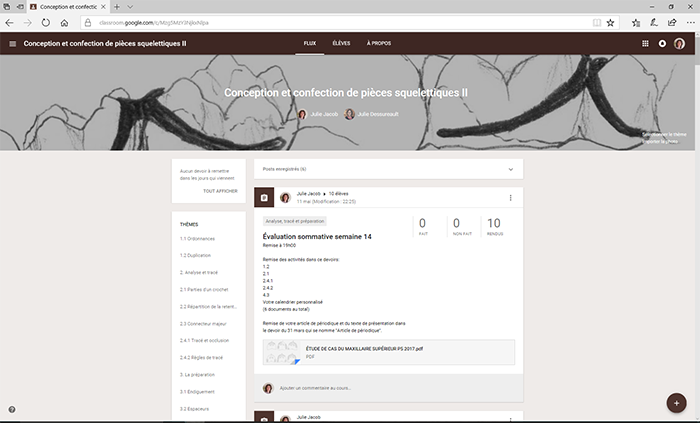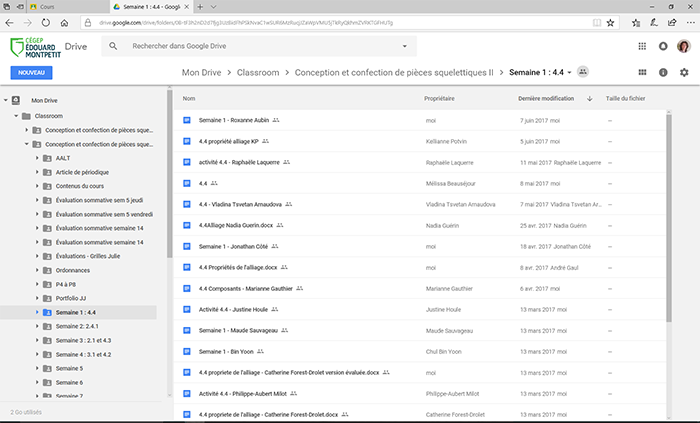Google Classroom to Support Sustainable Learning in the Dental Prosthesis Program
I teach in the Dental Prosthesis Program. During the winter session, I give the course Conception et confection de pièces squelettiques II to students in their 4th semester in the program. This course allows them to finish acquiring the skills essential for them to succeed the integration activity. However, the students do not have the opportunity to practice these skills between their 4th and 6th semester of studies. This means that 3rd year students sometimes have difficulty finding theoretical or practical notions from the year before. For this reason, I set out to find both, a way to ensure the safekeeping of course contents and a means of making the content easily accessible to the students.
Formerly, I asked the students to produce handwritten activities. Marking those assignments was tedious. Furthermore, few students benefited from the formative evaluation because they did not finish their work on time. In 2011, I felt the need to work more efficiently. I created a website with Google Sites, in which I asked students to create digital learning activities. The site was functional but not very user friendly. Google suite continued to develop and finally my college’s ICT Representative, Julie Dessureault, introduced me to the Google Classroom environment.
Setting up Classroom for my course
I started using Classroom in the 2017 winter session. The steps leading up to the creation of the course and signing up the students were very easy. Since 2016, the Cégep Édouard-Montpetit automatically signs up all of its students and teachers for G Suite for Education.
To join the course, the students go directly to Classroom and sign in using their college email address and network password. Classroom tells me who has and who hasn’t joined the course. This feature allows me to monitor students right from the start. Accordingly, I can plan for a personalised follow up to help those students who delay using the tool.
Most of my students did not know Classroom. I had to plan an activity in the computer lab to help them out. It is really necessary to take time to contextualise and especially to answer the famous question: “What’s in it for me?”
A flexible environment for learning activities
At first, I put the course plan in the “About” section. As weeks went by, I added announcements or homework assignments related to the theme seen in class. When a file is added to an announcement or an assignment a thumbnail appears beside it. The thumbnail acts as an aid to visually locate the file.


Each assignment added to Classroom by a student is automatically added to Google Drive file storage.
In addition to making organisation easier, I believe that associating assignments to a theme offers cognitive benefits.
Classroom offers great flexibility. Students have to complete several types of assignments. Sometimes it could be a drawing they have to do. They draw over the file that was made available using the application of their choice. A student admitted that she had completed her drawing in a waiting room using the handwriting annotation feature. Classroom works as well on a computer as on a mobile device making it very convenient.

Example of how a digital learning activity evolves (created with DocHub)
Another advantage is that Classroom makes shadowing assignments easy. I can follow their progression and step in rapidly which allows me to provide a better quality of formative feedback, sometimes carried out synchronously. I can change a comment after having written it or copy and paste a comment that comes back often rather that rewrite it each time. This ensures that marking is fair and consistent for all. I can also be sure of the authenticity of each assignment submitted because assignments are saved in digital format.
Classroom seems to encourage students to respect deadlines. It is the first year that my students, on the whole, respect the deadlines for assignments. If they don’t Classroom warns them that they are late. I think they don’t like getting this type of notification! Since I have started using Classroom, it is rare that students do not complete their assignment before coming to class.
Using Classroom as a digital portfolio
I use Classroom so that students, individually or as a team, can group together activities centered on skills development. The activities are personalised according to their learning style. Students choose the format that best suits them:
- Text
- Photos
- Tables
Teams can use Google docs and collaborate on the same activity.
Positive outcome for students
I held 2 surveys, one at mid-session and one at the end of the session, to find out what the students thought of their experience with Classroom. Their comments were mostly positive:
- They liked the speed with which they could access the course. All of the content was made available in the tool.
- They liked the rapidity with which they received feedback. They do not have to wait for their homework to be handed in, then handed back by the teacher, to receive formative comments.
- They appreciated the communication style. They used the “Private Comments” section to ask their questions.
- The exchanges enhanced their learning.
Among the improvements to be made, students mentioned the importance of better presenting the project. It is true that, from lack of experience, I had a hard time justifying the use of Classroom at the beginning of the session. With the benefit of hindsight, I now have several arguments that will allow me to present the approach well to students the next time.
Training closer to the reality of the workplace
Because the students will be doing the integration activity in the 2018 winter session, I cannot comment on any long-term impact of using Classroom. However, I encouraged my students to keep their documents on a personal Drive, to be able to access them after they finish their studies.
Our field is transitioning towards digital: there is a move towards computer-assisted design for making prosthesis formerly produced by hand. Yet, some students of the program do not seem comfortable with this. I think that an approach using Classroom will give them some insight into this reality and will help them fit into the workplace.
I believe that Classroom has the potential to meet the needs of many programs. It will be an asset for any course that requires collaborative work and the creation of activities for analysing and reflection.

